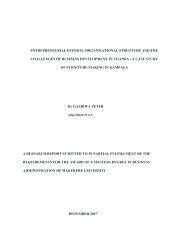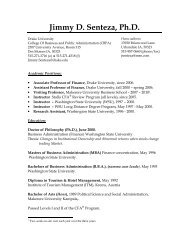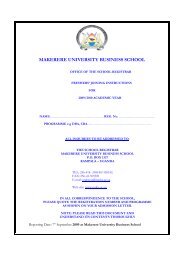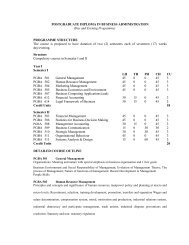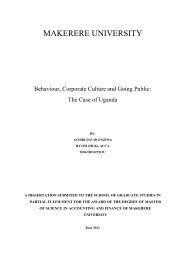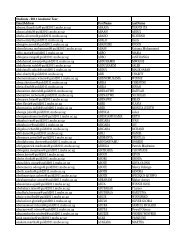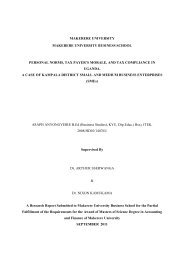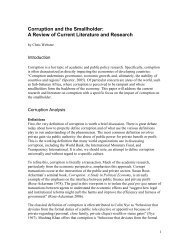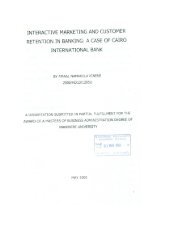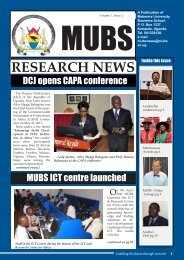13th Annual International Management Conference Proceeding
13th Annual International Management Conference Proceeding
13th Annual International Management Conference Proceeding
You also want an ePaper? Increase the reach of your titles
YUMPU automatically turns print PDFs into web optimized ePapers that Google loves.
organisation (Zahra, 1996). The renewal activities relate to the concept of a firm’s business and its<br />
competitive approach in the markets. Renewal is achieved through the redefinition of a firm’s mission<br />
through the creative redeployment of resources (Guth and Ginsberg 1990). Renewal requires developing or<br />
adopting new organisational structures that promote innovation and venturing. Renewal also covers systemwide<br />
changes, which enhance creative organisational learning and problem solving. These changes usually<br />
refocus small business’s basic values.<br />
2.3.2 The prerequisites of intrapreneurship<br />
Several researchers have attempted to understand the factors that stimulate or impede intrapreneurship. Areas<br />
such as external environment, organisation, its strategy, and management activities have been presented as<br />
factors affecting intrapreneurship (Guth and Ginsberg 1990, Miller 1983, Kuratko et al. 1990).<br />
<strong>Management</strong> activities refer to the role of management as a facilitator and promoter of intrapreneurship<br />
(Thompson 1999). <strong>Management</strong> activities ensure that the organisation has a clear and understood vision and<br />
direction. <strong>Management</strong> activities also affect the organisational culture in terms of the extent to which the<br />
basic assumptions of intrapreneurship (e.g. risk taking, innovation and creativity, learning, change) can be<br />
found within the organisation. Organisation culture is a system of shared meanings within an organisation<br />
that determines to a large degree how employees act (Robins and Coulter, 1999).<br />
The organisational setting includes the way work is being organised in the small businesses: power and<br />
responsibility, division of work, rules etc. Altogether, these organisational factors both direct the employees<br />
in their intrapreneurial efforts, as well as ensure that employees are empowered and committed (Thompson<br />
1999). Previous studies indicate that managerial support; organisational structure as well as reward and<br />
resource availability affects intrapreneurial activities within the organisation (e.g. Hornsby et al. 1993,<br />
Antoncic and Hisrich 2001).<br />
All the potential elements of intrapreneurship mentioned earlier are factors assumed to affect<br />
intrapreneurship at organisational level. However, within the practice of intrapreneurship the individual is<br />
the key actor, making it understandable why the intrapreneur herself/himself (either her/his personal<br />
attributes or her/his roles and functions) is also a focal area of intrapreneurship research. The individual<br />
skills and attitudes, also referred to in literature as the entrepreneurial orientation, describe the capabilities<br />
and willingness of any potential intrapreneur to act intrapreneurially (Sembhi, 2002).<br />
2.3.3 The outcomes of intrapreneurship<br />
It is evident that intrapreneurship can give grounds for competitive advantage of an existing organisation.<br />
The manifestations of such competitive advantage may be e.g. differentiation or cost leadership in the<br />
markets, quick response to any changes, new strategic direction or new ways of working or learning within<br />
the organisation (Covin and Miles, 1999). Prior research proposes that intrapreneurial processes are<br />
associated with an organisation’s financial performance (Zahra 1991, Zahra 1995, Zahra and Nielsen et al.<br />
1999, Antoncic and Hisrich 2001). For example, Zahra and Nielsen et al. (1999) raise the importance of<br />
organisational learning and knowledge creation as outcomes of intrapreneurial activities, and, thus, as<br />
grounds for competitive advantage and a basis of superior performance of the organisation. In this study<br />
organisation, performance does not include only financial performance, but also non-financial<br />
manifestations, such as customer satisfaction as well as job satisfaction of the employees.<br />
3.0 ANALYSIS OF KEY ISSUES AND CHALLENGES<br />
3.1 How does an intrapreneurial organisation look like?<br />
Intrapreneurship is partially responsible for successful management of service organizations. Nevertheless,<br />
public service organizations need to be well understood by entrepreneurs. They have multiple constituencies,<br />
long-standing organizational structures, employees with lifetime employment, and to say the least, "unique"<br />
decisions making processes. In addition, they have many subgroups bound together in a common goal of<br />
finding a ‘parking’ place. For success inculcation of intrapreneurship, the following aspects are crucial:<br />
49



